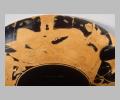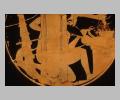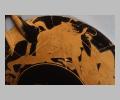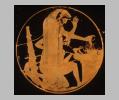| Collection: | Berlin, Antikenmuseen |
| Summary: | Interior: Herakles sacrificing, assisted by a satyr. Side A: satyr attacking a sleeping maenad. Side B: Herakles and Cerberus. |
| Ware: | Attic Red Figure |
| Painter: | Name vase of the Epidromos Painter |
| Date: | ca. 510 BC - ca. 500 BC |
| Dimensions: | H. 8.8 cm., d. 22.2 cm. |
| Primary Citation: | |
| Shape: | Cup |
| Period: | Archaic |
Condition:
The vase is in poor condition. The surface, especially on the exterior, has been eroded to the point that many of the details have been lost.
Decoration Description:
Interior: Herakles sacrificing, assisted by a satyr. A fire burns on the altar which stands on the right. Herakles, unusually dressed in a long tunic worn over his lion skin, holds a kantharos in the fire, his other arm raised in a salutory gesture. A satyr stoops beside him, mostly hidden by Herakles. He holds over the fire the end of a long stick. Herakles' club leans against the tondo 'wall' behind him.
Side A: satyr attacking a sleeping maenad. A naked maenad lies asleep, her head resting on one hand. She leans against a box or other square object covered by a cloth. Her hair is covered by a sakkos. The ithyphallic satyr crawls in from the left with his arms outstretched; one hand already grasps the sleeping girl's right arm.
Side B: Herakles and Cerberus. Herakles, guided by Hermes, leads Cerberus out of hell. Hermes, walking to the left, looks back and gestures to Herakles with his left hand, his traveler's staff held in his right hand. Herakles, following at a run, in turn looks back at Cerberus who is here depicted with only two heads, both snarling. Hermes wears a chlamys, petasos and winged boots, Herakles a short chiton and his lion skin.
Shape Description:
For the shape see Bloesch 94, Hieron no. 25.
Inscriptions:
On the interior:
Collection History:
The cup was acquired in the Ancona auction in Mailand in 1892. Its provenance is unknown.
Sources Used:
Other Bibliography:





